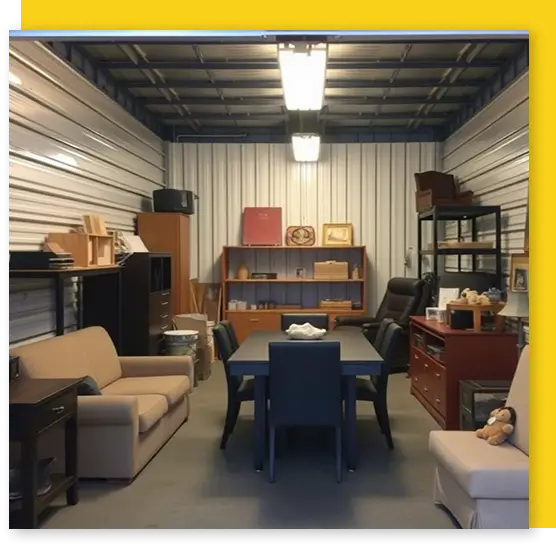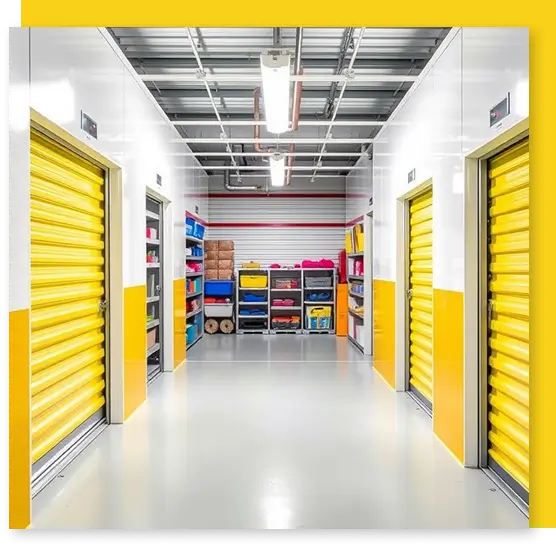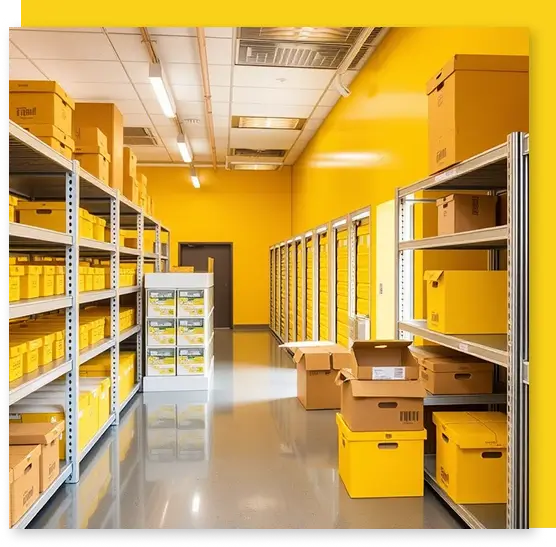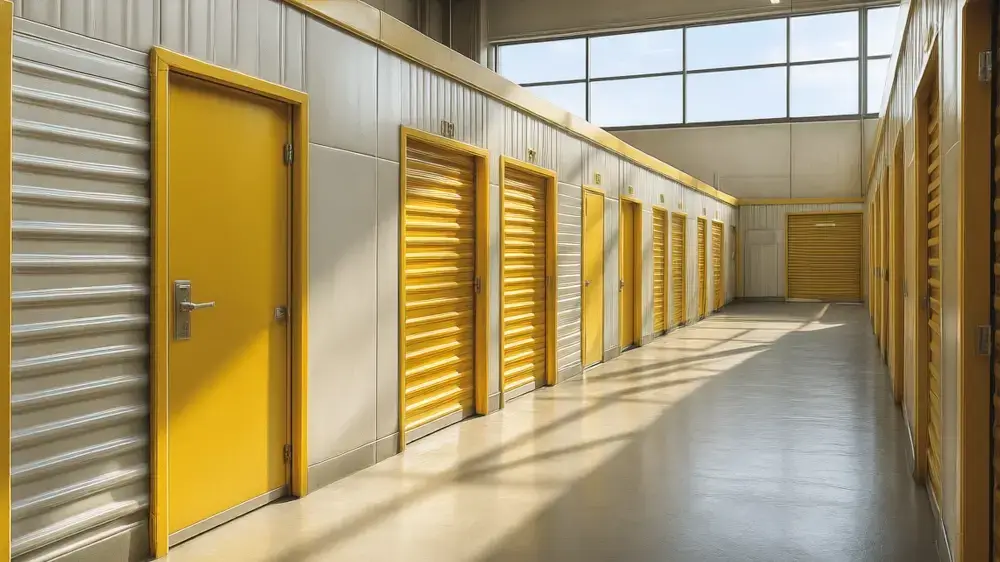In Dubai, the hot season typically lasts from mid-May to late September. Average August highs are ~106 °F (41 °C) and daily highs remain >100 °F across the hot season. These values push furniture materials beyond safe limits without active control. Indoor relative humidity at or above 60% increases mold risk. The EPA recommends 30–50% RH where possible. Repeated RH and temperature swings stress veneers, joints, and adhesives in furniture.
Recent UAE observations recorded 51.8 °C in Sweihan in August 2025 and mid-40s °C on the coast. Climate-controlled storage with documented set points and logs is therefore necessary for long-term protection of wood, leather, textiles, foams, and metal fittings.
What this guide covers:
Climate bands for furniture in Dubai, materials-safe packing that uses acid-free tissue, archival board, Tyvek, and closed-cell polyethylene foams, micro-environments with silica gel and data logging, and facility requirements that prove control rather than claim it.

What climate band keeps wood and veneered furniture dimensionally stable in Dubai storage?
Wood in furniture is hygroscopic. Veneers and cross-banded tops move with relative humidity. Dubai’s hot season lasts about 4.3 months from May 14 to September 24 with average daily highs above 100 °F. August averages ~106 °F (41 °C), so uncontrolled units amplify RH swings that stress joints and glues.
Keep storage at 45–55% RH and 15–25 °C with tight daily limits. A wider seasonal drift of 40–60% RH is acceptable if the change is gradual. Daily variation should stay near ±5% RH and ±4 °C. These bands align with ICOM-CC and IIC environmental guidance for mixed furniture collections.
Also read: Seasonal Storage Tips in UAE: Expert-Backed Guide for Storing Belongings Year-Round (2025)
How tight should daily fluctuations be in Dubai storage rooms?
Small daily swings prevent fatigue in veneers and joints. Sustained control reduces checking, splits, veneer lift, and adhesive creep in long-term furniture storage.
What do wood EMC values show about the need for RH control?
At about 20–21 °C, typical equilibrium moisture content for furniture woods is ~7–8% at 40% RH, ~9% at 50% RH, and ~10–11% at 60% RH. A step from 45% to 65% RH raises wood moisture by about 2–3 percentage points, which is enough to move joints or telegraph veneer edges.
What humidity level triggers mold risk on stored furniture?
Mold becomes more likely at ≥60% RH. The EPA recommends keeping indoor RH below 60%, ideally 30–50%. In Dubai’s humid months, non-conditioned units cross that threshold, so active control is required for long-term furniture storage.
Wood EMC reference values at ~20–21 °C
| Relative humidity | Typical wood EMC |
|---|---|
| 40% RH | ~7–8% |
| 50% RH | ~9% |
| 60% RH | ~10–11% |
Keeping 45–55% RH in climate-controlled storage reduces dimensional change in solid wood and veneered furniture.
How should furniture be stabilized before packing for Dubai storage?
Use a short, controlled acclimatization to reduce post-pack movement in the hot season.
- Hold pieces 24–48 hours in 45–55% RH and 18–25 °C before boxing or crating.
- Verify conditions with a calibrated hygrometer and temperature logger.
- Proceed to packing only after readings remain stable.
These steps mirror preventive-conservation practice for furniture materials.
Why Dubai climate data changes the storage choice
August daily highs near 106 °F and a hot season of ~4.3 months confirm that ventilation alone cannot maintain ≤25 °C or <60% RH inside metal units. Climate-controlled storage is necessary for long-term protection of wood substrates and veneers.

How should leather sofas and chairs be stored long-term in Dubai’s climate?
Leather is protein-based and absorbs moisture faster than finished wood. Dubai’s hot season runs ~4.3 months with average highs near 106 °F (41 °C), so climate-controlled storage is required to keep leather within a safe microclimate.
Which contact materials are safe against leather surfaces?
Use unbuffered acid-free tissue at contact points and archival Tyvek 1623E or cotton as breathable outer wraps. Unbuffered tissue avoids alkaline shift at the slightly acidic leather surface. Tyvek 1623E is micro-perforated and breathable for dust covers.
Storage targets for leather vs wood in Dubai facilities
| Furniture material | Operational RH | Temperature | Daily fluctuation |
| Leather upholstery | 45–65% | ≤25 °C | low, steady |
| Solid wood and veneers | 45–55% (seasonal 40–60%) | 15–25 °C | ≤5% RH, ≤4 °C |
What specific risks affect leather sofas and chairs in Dubai storage?
- Mold growth accelerates when RH crosses 60% and dust loads are present. Keep rooms <60% RH and inspect seams and underside panels.
- Heat-assisted oxidation and red rot increase as temperatures rise. Keep temperature ≤25 °C and avoid sealed plastic that traps moisture against finishes.
- Salt and skin oil residues on armrests promote soiling and microbial activity. Dry clean before storage to remove hygroscopic residues.
How should owners prepare leather furniture before packing it in Dubai?
- Condition check and dry clean: Photograph seams, cushions, and backs; vacuum through a screen; no dressings or oils unless a conservator prescribes them.
- Stabilize: Hold 24–48 hours in 45–55% RH and 18–25 °C to equalize cushions and backs before boxing.
- Pack: Interleave contact areas with unbuffered tissue; wrap seats and arms in Tyvek 1623E or cotton; avoid adhesive tapes on finishes.
- Place in climate-controlled storage: Contract setpoints and require RH and temperature logs for the hot season. Dubai’s summer highs near 106 °F make passive ventilation insufficient.
Do plastic wraps work for leather in humid months in Dubai?
Leather absorbs moisture quickly. Dubai’s August average high is about 106 °F (41 °C), and the hot season lasts ~4.3 months with daily highs above 100 °F. Sealed plastic traps moisture and raises the condensation risk on leather finishes in these conditions. Use breathable dust covers and keep indoor RH below 60%.
Long-term leather furniture storage in Dubai
- Prefer Tyvek 1623E or cotton covers. 1623E is pin-perforated (≈0.25–0.38 mm), which increases air and moisture permeability compared with sealed polyethylene.
- Follow leather storage bands of 45–65% RH and ≤25 °C with small daily swings to limit microbial growth and finish softening.
- Treat sealed plastic only as a loose, vented shroud when an enclosure already holds a stable microclimate. Pair with desiccant and verify RH with a hygrometer.
Checklist for safe covering of leather sofas and chairs
- Wrap contact surfaces with unbuffered acid-free tissue, then add Tyvek 1623E or cotton as the outer layer.
- Place conditioned silica gel inside cases or drawers to hold the enclosure near ~50% RH.
- Measure RH and temperature at intake and after 24 hours; keep RH <60% and T ≤25 °C.
- Avoid cling films and tight plastic seals during humid months. Replace covers that show condensation or odor.
Breathable covers and sealed plastic in Dubai storage: differences
| Property | Breathable cover (Tyvek 1623E or cotton) | Sealed plastic wrap |
| Vapor movement | Allows limited air exchange that reduces surface condensation | Traps moisture and increases condensation risk |
| RH management | Works with silica gel to maintain <60% RH in enclosures | Counteracts buffering and can spike local RH |
| Surface interaction | Low abrasion and no adhesive transfer | Condensation can soften finishes and print plastic |
| Fit for Dubai heat | Suitable with climate control and logging | Not recommended for long-term storage |
How often should leather furniture be inspected during long-term storage in Dubai?
Inspection cadence must match climate risk. Museums accept six-monthly reviews in benign climates, but Dubai’s hot season justifies monthly checks from May to September because RH excursions above 60% increase mold risk on leather.

What authoritative guidance says about thresholds and stability
- The EPA states indoor RH should be below 60%, ideally 30–50%.
- Museum programs for leather storage set 45–65% RH and ≤25 °C, with small daily fluctuation.
Monthly inspection sequence for leather sofas and chairs
- Verify environment: Download logger data since the last visit; confirm RH trend <60% and temperature ≤25 °C.
- Check microbial indicators: Seams, zippers, underside panels, and cushion interfaces for bloom or odor. If RH reached ≥60%, isolate and dry promptly.
- Assess surface condition: Tackiness, dye transfer, or whitening; these suggest moisture or finish issues.
- Confirm wrapping: Breathable cover intact, no sealed plastic, interleaves clean, no condensation.
- Adjust the microclimate: Weigh or replace silica gel; for every 5 liters (5000 cm3) of volume within the container, add 400 grams of silica gel.
- Record evidence: Date-stamped photos and a short note of any corrective action for your RH/temperature log.
Which packing materials are inert and furniture-safe for long-term storage in Dubai?
Furniture finishes and adhesives react to acids, dyes, and migrating plasticizers. Dubai’s hot season pushes RH above safe limits without control, so packing materials must be chemically inert, low-emission, and mechanically resilient to protect wood, veneers, leather, textiles, and metal fittings in climate-controlled storage.
What materials qualify as inert for furniture packing and supports?
Closed-cell polyethylene foams and acid-free paper systems are widely accepted for furniture storage. Ethafoam is a polyethylene foam that is closed-cell, chemically resistant, and resilient, which makes it suitable for pads, edge blocks, and cradle supports under carved arms, veneer edges, and feet.
Are all “archival” papers equivalent for contact with furniture surfaces?
“Archival” is not a controlled term. The Photographic Activity Test, ISO 18916, verifies enclosure reactivity, but passing PAT does not guarantee full archival performance or protection from plasticizers or adhesive migration. Choose acid-free, lignin-free papers, then match buffered or unbuffered to the surface. Museum guidance uses unbuffered tissue next to protein-based materials such as leather or silk, and uses buffered papers for cellulose-based materials, such as drawers lined with paper, because the alkaline reserve counters acidic migrants.
Which plastics should be avoided around furniture finishes during storage in Dubai?
Polyurethane foams deteriorate by hydrolysis and oxidation. They yellow, become brittle, and crumble, and they can off-gas products that damage nearby surfaces. Conservation databases and Conserve O Gram notes advise avoiding polyurethane foams near collection surfaces and using polyethylene foams instead.
Packing materials for long-term furniture storage in Dubai facilities
| Material | Composition and key spec | Museum use | Risks and notes | Fit for Dubai climate-controlled storage |
| Ethafoam 220 | Closed-cell polyethylene foam, 35.2 kg/m³ density plank | Pads, edge blocks, bases under feet, crate linings | Stable and low emission; avoid UV exposure | Suitable for long-term support and vibration control |
| Polyethylene foam, generic | Closed-cell PE foams, chemically resistant and resilient | Shock-absorbing cushions and separators | Good chemical resistance; select closed-cell grades | Appropriate when cut to fit and kept clean |
| Acid-free tissue, unbuffered | pH neutral, no alkaline reserve | Direct contact with leather, silk, and protein textiles | Prevents alkaline shift at protein surfaces | Use as an interleave and wrapping layer |
| Acid-free tissue, buffered | pH 7.5–9 with alkaline reserve 2–3% CaCO₃ | Drawers, shelves, paper-lined areas | Not for direct contact with proteinaceous materials | Adds resistance to acidic migrants in cellulose |
| Tyvek 1623E | Pin-perforated HDPE non-woven; perforations 0.25–0.38 mm; ~41.5 g/m², ~145 µm thick | Breathable dust covers and abrasion guards | Breathable yet water-repellent; reusable | Ideal outer wrap over tissue in humid months |
| Polyurethane foam | Thermoset or thermoplastic urethane | Should not contact furniture surfaces | Yellowing, crumbling, off-gassing; accelerated by heat and humidity | Avoid near sensitive finishes and adhesives |
How should inert materials be combined around furniture for Dubai storage?
A layered system protects finishes and controls moisture at the contact points.
- Contact layer: Unbuffered acid-free tissue for leather and protein textiles; buffered tissue for paper-lined drawers. This respects surface chemistry while preventing dye transfer.
- Wrap layer: Tyvek 1623E or cotton as a breathable dust cover that allows limited vapor movement. Pin-perforations 0.25–0.38 mm increase permeability, which reduces condensation events compared with sealed polyethylene film.
- Support layer: Ethafoam 220 pads or custom blocks under feet, corners, and edges to distribute loads and absorb shock during handling and storage.
Why do these material specs matter for long-term furniture storage in Dubai?
Dubai’s summer brings multi-week periods with outdoor highs near 41 °C and persistent humidity. Sealed, non-breathable wraps can trap moisture, while reactive foams can off-gas. Inert polyethylene foams, acid-free papers chosen to match surface chemistry, and breathable Tyvek covers reduce the risk of mold, veneer creep, and finish printing inside climate-controlled storage.

What data access proves that conditions are stable over time?
A credible facility shares monthly RH and temperature graphs and keeps a written monitoring plan. NEDCC and the NPS Museum Handbook require systematic monitoring with instruments designed for temperature and relative humidity, graphing, and written responsibilities for placement, collection, and review.
Sampling cadence and calibration must be explicit. NPS Conserve O Gram 3/3 notes long-term collections monitoring commonly samples every 20–30 minutes and explains calibration intervals (6–36 months depending on the logger and manufacturer). COG 3/2 covers hygrometer calibration procedures using psychrometers. Require both the sampling interval and calibration schedule in writing.
What pest documentation shows preventive control rather than reaction?
An Integrated Pest Management (IPM) plan with trap maps, inspection frequency, and cleaning cadence is standard museum practice. NPS guidance requires detection and monitoring with sticky traps and directs replacement and recording on a routine schedule. Ask for the site’s current IPM plan and the last two inspection reports.
What material policy keeps furniture finishes safe during storage?
Written policies must specify archival interleaves, Tyvek sleeves, and closed-cell polyethylene foams and must exclude polyurethane foams that degrade and off-gas in heat and humidity. These materials and prohibitions are drawn from museum preventive conservation practice.
What should a Dubai provider supply before accepting furniture for long-term storage
| Requirement | Acceptable proof | Standard or rationale |
|---|---|---|
| Climate setpoints | Documented 15–25 °C and ~45–55% RH with seasonal 40–60%; daily ±4 °C and ±5% RH | IIC and ICOM-CC environmental guidelines for collections. |
| Alarm thresholds | Written alarms at >26 °C or ≥60% RH with notification workflow | Upper limits tied to guideline bands and EPA mold threshold. |
| Monthly data access | Graphs and raw logs for the last 12 months; logger sampling 20–30 min; device calibration 6–36 months | NPS COG 3/3 for logging practice and recalibration ranges; NEDCC on written monitoring programs. |
| Local temperature policy | Statement that rooms follow 21–25 °C, where applicable | Dubai Municipality storage guideline. |
| IPM documentation | Current IPM plan, trap layout, inspection frequency, and the last two reports | NPS IPM guidance and sticky-trap monitoring practice. |
| Materials policy | List of acid-free interleaves, Tyvek covers, closed-cell PE foam; no polyurethane foam | Museum housekeeping and materials standards for collections. |
What should you request from a climate-controlled storage provider in Dubai?
Use a short, verifiable checklist that fits long-term furniture storage.
- Environmental statement: With setpoints, daily and seasonal fluctuation limits, and alarm thresholds for >26 °C and ≥60% RH.
- Monitoring package: Last 12 months of Temp and RH graphs, sampling interval 20–30 minutes, and a calibration schedule for each logger.
- IPM dossier: Current plan, trap map, inspection cadence, and housekeeping schedule that covers aisles, wall gaps, and under-furniture zones.
- Materials list: Acid-free tissues, Tyvek sleeves, closed-cell PE foam supports, and a written ban on polyurethane foams against finishes.
- Local compliance note: Confirmation that storage rooms are operated within 21–25 °C where municipal guidance applies.

Also read: Vacant Villa Problems in Dubai? Here’s How Holiday Homeowners Use Self Storage to Solve Them
Conclusion: How to keep furniture safe in Dubai storage for the long term
Climate control is non-negotiable in Dubai. August averages about 41 °C (106 °F), and the hot season spans ~4.3 months with daily highs above 38 °C (100 °F). These conditions push stored furniture beyond safe limits without active RH and temperature management.
Hold storage rooms near 15–25 °C and 45–55% RH, with a gradual seasonal drift to 40–60% RH. Keep daily changes tight at about ±4 °C and ±5% RH. Keep indoor RH below 60% to limit mold growth on wood, leather, and upholstery. Enclosures with silica gel help hold ~50% RH when the room drifts. Continuous monitoring plus written logs proves control rather than claiming it.
Dubai’s 2025 heat spiked to 51.8 °C in Sweihan and mid-40s along the coast. Choose facilities that share graphs, alarms, calibrations, IPM logs, and an approved materials policy that uses Tyvek, acid-free papers, and closed-cell polyethylene foams. Avoid sealed plastics and reactive polyurethane foams.
Key takeaways for long-term furniture storage in Dubai
- Target 45–55% RH, allow 40–60% seasonally, and hold 15–25 °C with tight daily limits.
- Keep RH <60% to deter mold; verify with monthly logger reports.
- Use Tyvek 1623E, acid-free tissue, and Ethafoam supports; avoid polyurethane foams and sealed wraps.
- Contract for data access and alarm thresholds at ≥60% RH or >26 °C to trigger action.
FAQs
What temperature and RH protect mixed furniture materials in Dubai storage?
Use 15–25 °C and 45–55% RH with seasonal drift of 40–60% and daily limits of about ±4 °C and ±5% RH. These limits reduce veneer lift, checking, and corrosion.
Why is 60% RH the practical mold threshold for stored furniture?
EPA guidance recommends indoor RH below 60% and ideally 30–50%. Mold risk rises above 60% in rooms and inside crates without buffering.
How hot does Dubai get during storage months?
The hot season lasts ~4.3 months from mid-May to late-September. August averages an average high of 41 °C (106 °F) in Dubai.
Do non-climate units work for multi-year furniture storage?
No. Coastal highs reach the mid-40s °C, and the inland UAE hit 51.8 °C in August 2025. Ventilation alone cannot hold ≤25 °C or <60% RH.
What logs should a facility share to prove control?
Monthly temperature and RH graphs, sampling every 20–30 minutes, plus calibration intervals for sensors. Keep written monitoring responsibilities.
Which wraps and pads are safe next to furniture surfaces?
Use unbuffered acid-free tissue against leather and Tyvek 1623E or cotton as breathable covers. Use closed-cell polyethylene foams for pads and blocks.
Which materials should be avoided around furniture finishes?
Avoid polyurethane foams because they yellow, crumble, and off-gas in heat and humidity. Avoid sealed polyethylene wraps that trap moisture. Use breathable covers instead.
How long should furniture acclimate before packing?
Hold pieces 24–48 hours at 45–55% RH and 18–25 °C before boxing or crating. This reduces post-pack movement and veneer stress.
What RH should I target inside drawers and crates?
Aim for ~50% RH using conditioned silica gel and gaskets. Recheck monthly and regenerate gel per the manufacturer’s charts.
Why do I need an IPM plan for furniture storage?
Heat and humidity increase pest pressure. Facilities should show trap maps, inspection frequency, and cleaning cadence to reduce risk under and behind furniture.


